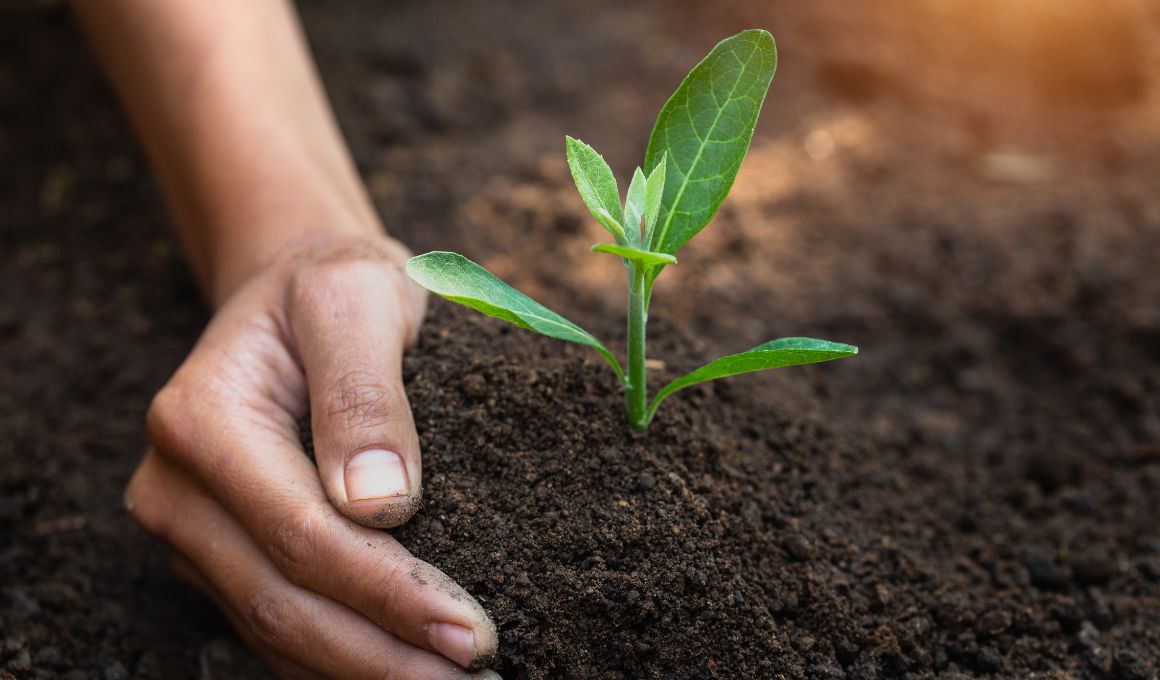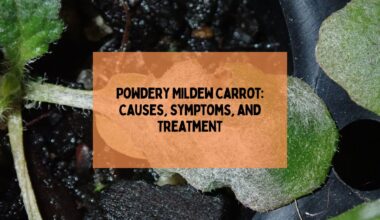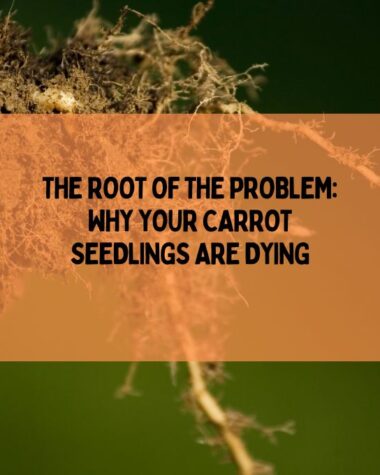Controlling yellowing carrots crops is crucial for ensuring a healthy and productive harvest. Yellowing, or chlorosis, can be caused by various factors, including nutrient deficiencies, soil pH imbalances, and pest infestations. Identifying the underlying cause of yellowing is critical to finding an effective solution.
In this article, I will explore the common causes of yellowing in aster and carrot crops and provide practical tips and best practices for preventing and controlling yellowing. We will cover a range of solutions, including soil preparation, irrigation techniques, fertilization, natural and chemical pesticides, crop rotation, and post-harvest care.
By the end of this article, you will understand how to keep your aster and carrot crops healthy and thriving.
Understanding the Causes of Yellowing in Aster and Carrot Crops

Various factors, including nutrient deficiencies, soil pH imbalances, and pest infestations, can cause yellowing in aster and carrot crops.
This section will discuss each of these causes in detail, including their symptoms, how to diagnose them, and potential solutions.
Nutrient deficiencies
Nutrient deficiencies can cause yellowing in plants when they lack the essential nutrients for growth and development. Common nutrient deficiencies in aster and carrot crops include nitrogen, iron, and magnesium.
Symptoms of nutrient deficiencies may vary depending on the nutrient but often include yellowing leaves, stunted growth, and poor plant vigor. A soil test or leaf tissue analysis can be conducted to diagnose nutrient deficiencies.
Once the specific nutrient deficiency is identified, appropriate fertilization techniques can be used to remedy the deficiency.
Soil pH

Soil pH can also impact plant growth and contribute to yellowing in aster and carrot crops. Soil pH measures the acidity or alkalinity of the soil and affects the availability of nutrients to plants.
Soil pH values between 6.0 and 7.0 are ideal for aster and carrot crops. If the soil pH is too low (acidic) or too high (alkaline), plants may struggle to absorb nutrients and can exhibit yellowing symptoms. To measure soil pH, a soil test can be conducted.
Solutions for correcting soil pH may include the addition of soil amendments such as lime or sulfur.
Pests and diseases

Pests and diseases can also contribute to yellowing in aster and carrot crops. Common pests affecting these crops include aphids, thrips, and spider mites, while common diseases include aster yellows and damping-off.
Symptoms of pest and disease infestations may include yellowing leaves, wilting, and stunted growth. Various methods can be used to prevent and control pests and diseases, including natural and chemical pesticides, crop rotation, and proper sanitation practices.
By understanding the causes of yellowing in aster and carrot crops, growers can take proactive steps to prevent and control this issue. The following section will discuss best practices for preventing yellowing in these crops.
Related Read
- The Ultimate Guide To Cucumber Pests and Diseases
- How to Find, Prevent, and Treat Zucchini Plant Problems?
- 10 Tomato Diseases – How to Recognize, Treat, and Prevent?
Best Practices for Preventing Yellowing in Aster and Carrot Crops
Preventing yellowing in aster and carrot crops is critical to ensuring a healthy and productive harvest.
This section will cover some of the best practices for preventing yellowing, including soil preparation, proper irrigation techniques, and crop rotation.
Soil preparation

Proper soil preparation is essential for preventing yellowing in aster and carrot crops. This includes testing soil quality and making any necessary amendments before planting. Soil tests can determine the nutrient levels and pH of the soil, allowing growers to make informed decisions about fertilization and soil amendments.
Common soil amendments for improving soil quality include compost, manure, and vermiculite. Growing plants can help prevent yellowing and promote healthy growth by providing the proper nutrients and soil pH.
Proper irrigation techniques

Watering is another crucial factor in preventing yellowing in aster and carrot crops. Over-watering or under-watering can both lead to yellowing and other stress-related issues.
Proper irrigation techniques include watering deeply and infrequently rather than frequently and shallowly. This allows the plants to develop deep root systems and access moisture more efficiently.
The amount and frequency of watering may vary depending on climate, soil type, and plant variety, so it’s essential to adjust irrigation practices accordingly.
Crop rotation

Crop rotation is another effective way to prevent yellowing in aster and carrot crops. Rotating crops can help reduce pest and disease pressure and replenish soil nutrients.
By planting different crops in a particular area each year, growers can prevent pests and diseases from building up in the soil and avoid depleting specific nutrients. For example, planting legumes like peas or beans can help replenish soil nitrogen levels.
Crop rotation is significant for controlling soil-borne diseases, such as damping-off, that can lead to yellowing and poor growth.
By implementing these best practices, growers can prevent yellowing in aster and carrot crops and promote healthy growth and productivity.
The following section will discuss additional solutions for controlling yellowing, including natural and chemical pesticides and post-harvest care.
Also, Read
- The Management Of Carrot Cotton Root Rot And Its Treatment
- The Ultimate Guide To Recognizing And Managing Cercospora Leaf Blight In Carrots
- Can You Grow Carrots? / What Are Some Common Carrot Varieties?
Controlling Yellowing in Aster and Carrot Crops
Fertilization Techniques

Fertilization is essential for providing nutrients to prevent yellowing in aster and carrot crops. There are different types of fertilizers available, including organic and synthetic fertilizers.
Organic fertilizers are derived from natural sources, such as compost or manure, while synthetic fertilizers are manufactured chemically. Organic fertilizers are generally preferred, as they provide a slower release of nutrients, which reduces the risk of over-fertilization and nutrient runoff.
However, synthetic fertilizers can be more easily customized for specific nutrient deficiencies. Application methods for fertilizers include broadcasting, where the fertilizer is spread evenly over the soil surface, and banding, applied in a narrow band along the plant rows.
Fertilizers can also be applied through drip irrigation systems, which provide a slow and steady release of nutrients directly to the plants’ roots.
Natural Pesticides and Fungicides

Natural pesticides and fungicides can effectively prevent yellowing in aster and carrot crops while minimizing the use of synthetic chemicals. Natural pesticides and fungicides include neem oil, garlic, and diatomaceous earth.
Neem oil is derived from the neem tree and can control various pests and diseases. It works by disrupting insects’ growth and feeding patterns and inhibiting the development of fungal diseases. Garlic can also be used as a natural pesticide and fungicide.
It contains sulfur, which has anti-fungal and anti-bacterial properties. Diatomaceous earth is a powdery substance made from the fossilized remains of diatoms. It can be sprinkled on the soil or plants to control pests by dehydrating their exoskeletons.
To make and apply natural pesticides and fungicides, growers can follow various recipes and application methods found in gardening resources.
It is important to note that while natural pesticides and fungicides can be safer for the environment and humans than synthetic chemicals, they may also harm beneficial insects, so use them judiciously.
Chemical Pesticides and Fungicides

While natural pesticides and fungicides can be effective, chemical pesticides and fungicides are sometimes necessary to control pests and diseases that threaten crop health. Various chemical pesticides and fungicides include insecticides, herbicides, and fungicides.
It’s essential to choose a product specifically designed for the pest or disease in question and follow the label instructions carefully.
Growers should take safety precautions when using chemical pesticides and fungicides, including wearing protective clothing and avoiding spraying on windy days or when the temperature is too high. It is also essential to properly store and dispose of unused chemicals.
Post-Harvest Care
Proper post-harvest care is crucial for preventing yellowing in aster and carrot crops. After harvesting, removing any plant debris and discarding damaged or diseased plants are essential. Thoroughly cleaning and sanitizing tools and equipment can help prevent the spread of diseases from one season to the next.
Also, properly storing harvested crops is essential for preventing yellowing and maintaining quality. For example, carrots should be stored in a cool, dry place with high humidity to prevent them from drying out and becoming tough. Properly storing crops can also prevent the growth of mold and other fungi, which can cause yellowing and other quality issues.
Harvesting and Post-Harvest Care
After all the hard work, you’ve finally grown your aster and carrot crops. Congratulations! Now, it’s time to harvest and take good care of your crops to prevent post-harvest diseases. Here are some tips on how to do that.
Proper Harvesting Techniques
When harvesting carrots, pull them gently from the ground, careful not to break them. The leaves should be cut off right at the base of the stem, leaving about an inch of the stem intact. This will help prevent any post-harvest diseases from spreading.
On the other hand, aster plants should be harvested when the flowers have fully bloomed. Cut the stems at the base, leaving enough stems attached to the flowers for easy handling.
How to Store Your Crops
Once you’ve harvested your crops, storing them properly is essential to prevent spoilage. Carrots should be stored in a cool, dry place, such as a root cellar or refrigerator, to prevent drying. They can be stored in perforated plastic bags or in a container filled with damp sand to keep them moist.
It should be stored in a cool, dark place like a refrigerator or basement. Make sure to keep them away from direct sunlight or heat sources. You can store them in a vase with water or in a damp paper towel to keep them fresh.
How to Prevent Post-Harvest Diseases
Post-harvest diseases can be a significant problem for aster and carrot crops. Here are some tips to prevent them:
- Proper sanitation: Clean all your tools and equipment before and after use to prevent the spread of diseases.
- Proper storage: Store your crops in a cool, dry, and dark place to prevent the growth of fungi and bacteria.
- Ventilation: Ensure proper ventilation in the storage area to prevent moisture buildup, which can cause mold and rot.
- Inspection: Regularly inspect your stored crops for any signs of disease or spoilage. Remove any infected or spoiled crops immediately to prevent the spread of disease.
By following these tips, you can ensure that your aster and carrot crops are harvested and stored correctly and are free from post-harvest diseases.
Final Thoughts
Controlling yellowing in aster and carrot crops can be challenging, but with the proper knowledge and techniques, it’s possible to have a successful harvest.
This article covers the causes and symptoms of carrot crops infected with aster yellows, best practices for preventing yellowing, and techniques for controlling yellowing using fertilization, natural and chemical pesticides, and fungicides.
We have also provided tips for proper harvesting and post-harvest care to prevent yellow aster disease.
Implementing this article’s techniques and best practices ensures that your aster and carrot crops are healthy and vibrant.
Constantly monitor your crops and respond promptly to any signs of yellowing or disease. You can harvest aster and carrot crops successfully with the proper care and attention.
Happy Gardening!







